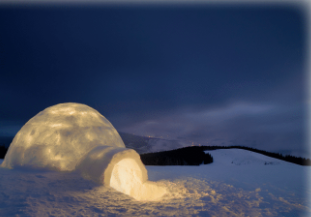WHAT HOUSE-BUILDERS CAN LEARN FROM IGLOOS
How, when and where did the igloo evolve? No one knows for sure, but only specific Inuit communities built them traditionally in relatively small areas of Greenland and Canada. They used them for temporary accommodation in winter months or on hunting expeditions. What’s more certain and a little bit surprising is that the humble igloo has a lot to teach the modern British house-builder. Last year, a report by the government’s architecture watchdog, Cabe, found more than four in five new homes built in Britain since 2002 failed to meet the needs of those who came to live in them. An Igloo’s design and construction principles are enduring. They are also a response to the essential reasons people build: to shelter from the elements and provide protection from danger. However, the way the igloo achieves these basic aims is ingenious, which raises it from a mere utilitarian structure to a piece of architecture. It is not just a highly functional structure but also a creation of elemental beauty. The igloo utilizes the potentially weakest of building materials, frozen water. It gives this unlikely structural material immense strength. Its domed form is not only beautiful. In many cultures, it is a sacred form representing the heavens and divine creation. Its domed shape is also very strong. Frozen water, or snow and ice, also has other striking qualities. It’s the only readily cheap and available building material in much of the Arctic. It is also a totally renewable resource. It’s a construction material that causes no pollution in its manufacturing, use or disposal.

